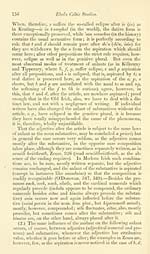Blair Collection > Celtic studies
(187)
Download files
Complete book:
Individual page:
Thumbnail gallery: Grid view | List view

On Phonology in IrisJi. 155
Irisli with the loss of this umlaut ; all feminine and consonantal
stems formed both cases alike, from the beginning with /-um-
laut; there only remained, consequently, the difterence of the
auslaut towards the anlauts following. But we have already
seen in the case of the pronominal suffixes, that the dative has
only maintained itself after de and do in diobh and doibh; on
the other hand, the accusative has come in after all other pre-
positions, as the pecuhar phonetic phenomena in aea^ etc., show;
consequently in that which the grammarians call the dative sin-
gular, a true dative is only to be recognized after de and do;
after other prepositions, on the other hand, the accusative ; and
we should not wonder that in Keating, and in the North Minister
dialect, the article gives rise to aspiration only in these cases
(both prepositions, except in the County of Kilkenny, sound alike
do), while everywhere else it produces eclipse. Here, also, then,
similarity of form has gone hand in hand with syntactical cor-
ruption ; the INIodern Irish is surpassed in the latter respect by
the Modern Greek, which has wholly lost the dative, and even
combines airo and fii (jx^to) with the accusative. The occur-
rence of the dative after all prepositions (even gan and idir) in
the plural of substantives, is, no doubt, due to an efibit to gain a
prominent distmction, which was not given here by the form of
the article {na without change of sound). Hence there have
been preserved pure in the written language, the dative plural,
only that already in the earhest times the article had begun to
become truncated to na, the genitive singular and plural, and
the nominative singular, in all instances; the dative singular,
on the other hand, only after de, do, the acccusative singular
after the other prepositions {gan and idir excepted), never as
objective case, the nominative and accusative plm-al only where
they have sounded ahke as in the vocalic feminine stems, other-
Avise they are always confounded. If we now study the treat-
ment of the anlaut after the article, everything may be satisfac-
torily explained conformably to the old rule, e. a.: —
Irisli with the loss of this umlaut ; all feminine and consonantal
stems formed both cases alike, from the beginning with /-um-
laut; there only remained, consequently, the difterence of the
auslaut towards the anlauts following. But we have already
seen in the case of the pronominal suffixes, that the dative has
only maintained itself after de and do in diobh and doibh; on
the other hand, the accusative has come in after all other pre-
positions, as the pecuhar phonetic phenomena in aea^ etc., show;
consequently in that which the grammarians call the dative sin-
gular, a true dative is only to be recognized after de and do;
after other prepositions, on the other hand, the accusative ; and
we should not wonder that in Keating, and in the North Minister
dialect, the article gives rise to aspiration only in these cases
(both prepositions, except in the County of Kilkenny, sound alike
do), while everywhere else it produces eclipse. Here, also, then,
similarity of form has gone hand in hand with syntactical cor-
ruption ; the INIodern Irish is surpassed in the latter respect by
the Modern Greek, which has wholly lost the dative, and even
combines airo and fii (jx^to) with the accusative. The occur-
rence of the dative after all prepositions (even gan and idir) in
the plural of substantives, is, no doubt, due to an efibit to gain a
prominent distmction, which was not given here by the form of
the article {na without change of sound). Hence there have
been preserved pure in the written language, the dative plural,
only that already in the earhest times the article had begun to
become truncated to na, the genitive singular and plural, and
the nominative singular, in all instances; the dative singular,
on the other hand, only after de, do, the acccusative singular
after the other prepositions {gan and idir excepted), never as
objective case, the nominative and accusative plm-al only where
they have sounded ahke as in the vocalic feminine stems, other-
Avise they are always confounded. If we now study the treat-
ment of the anlaut after the article, everything may be satisfac-
torily explained conformably to the old rule, e. a.: —
Set display mode to: Large image | Transcription
Images and transcriptions on this page, including medium image downloads, may be used under the Creative Commons Attribution 4.0 International Licence unless otherwise stated. ![]()
| Early Gaelic Book Collections > Blair Collection > Celtic studies > (187) |
|---|
| Permanent URL | https://digital.nls.uk/75773425 |
|---|
| Description | A selection of books from a collection of more than 500 titles, mostly on religious and literary topics. Also includes some material dealing with other Celtic languages and societies. Collection created towards the end of the 19th century by Lady Evelyn Stewart Murray. |
|---|
| Description | Selected items from five 'Special and Named Printed Collections'. Includes books in Gaelic and other Celtic languages, works about the Gaels, their languages, literature, culture and history. |
|---|

